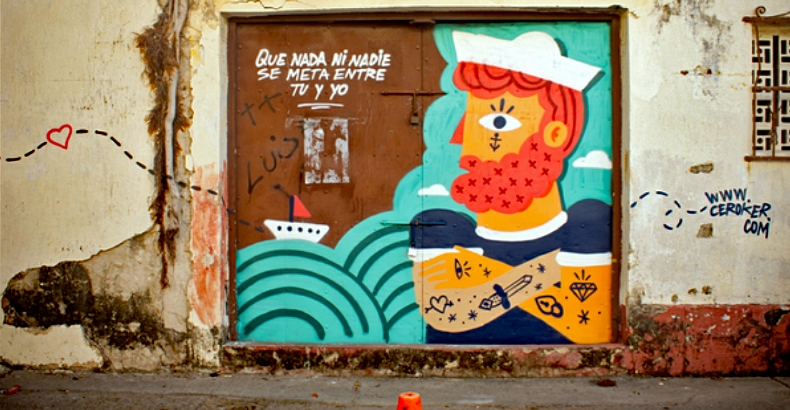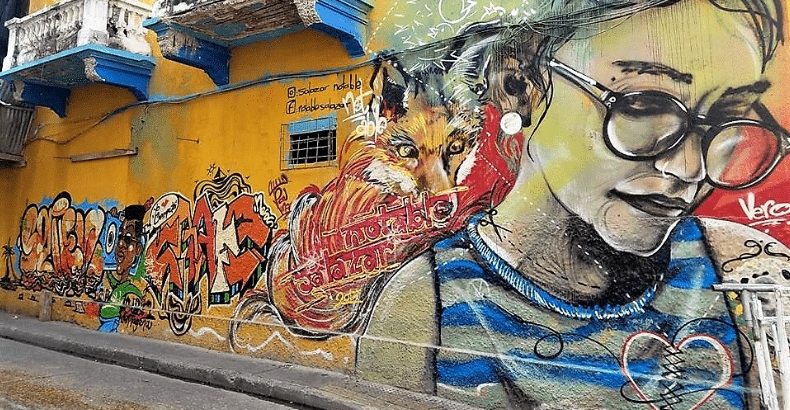Continued from Part 1…
Maria Mulata by Yurika MDC: Another member of the Vértigo Graffiti collective, Yurika MDC based this mural (located in the Plaza de la Trinidad, behind the statue of Pedro Romero) on a local legend that tells of a time, long ago, when brightly colored songbirds—called Maria Mulatas—flew above the town. Then, one day, a fiery inferno broke out, and with Cartagena up in flames, the townspeople were trapped. The colorful, musical birds heard the townsfolks’ cries for help and descended on them, plucking them off the street (using their long beaks) and carrying them safely. As a result of flying through all that soot and smoke, however, Maria Mulatas’ vibrant plumage turned black. And while the birds remain black, to this day, it is said that if you examine one up-close on a sunny day, you can catch a glimpse of those fantastic colors.
Que Nada Ni Nadie Se Meta Entre Tú Y Yo by Ceroker: Already painting on the streets of Bogota at the age of 14, the Colombian artist known as Ceroker (nee Camilo Gordillo) has risen to fame as a result of the stories each of his works tell, his masterful use of color, and the cheerful characters he creates. The name of this mural (and the quote at the top of it)—found on the neighborhood’s Calle Larga—translates to “Let nothing and nobody get between you and me.” Meanwhile, the pairing of the verbiage with the imagery of the tattooed sailor gives me a vibe that lands somewhere between Tom of Finland and the song “In the Navy” by the Village People, with an inherent sweetness that puts a big smile on my face.
The Fox and the Hair by Notable Salazar: I know very little about the artist known as Notable Salazar (nee Fabián Salazar) other than he hails from Santa Maria, Colombia—where, in addition to his studio, he also has a tattoo parlor—but I love his work. And not for nothing, but the play on the homophonous words Hare and Hair is pretty damn sublime, especially considering they sound nothing alike in Spanish! Meanwhile, you know I’m gonna love anything that alludes to a Russian folktale! *
Defender Lo Que Nos Queda by El Decertor: Believing that street art is a form of social activism, Peruvian artist El Decertor (nee Daniel Cortez)—who self-identifies as a painter-sculptor—is heavily influenced by the architecture and social context of the sites he chooses for his murals. His 2013 installation in Barrio Getsemani, Defender Lo Que Nos Queda (Defend What We Have) tells the story of the neighborhood’s inhabitants, and their struggles, in the face of rampant gentrification and displacement, to preserve their community’s identity. Think of it as protest art.
No Se Vende by Jade Rivera: Creating a higher level of consciousness—specifically with regards to everything that we humans continue to create and build, that he feels we have a responsibility to preserve—is the impetus behind the work of another Peruvian artist, Jade Rivera (nee Jonatan Rivera). In a similar vein to fellow countryman, El Decertor, Rivera also sounds off (visually, of course), on the issue of Getsemani’s gentrification. His mural, No Se Vende (Not For Sale) depicts a young neighborhood boy from a working-class family, who flies the flag of Cartagena de Indias in protest to the soaring prices of housing brought about by gentrification. Says Rivera of his oeuvre, “My paintings remind me that we die every second and fade away.”
Ciudad Mural by El Pez: Originally hailing from Barcelona, where he got into street art in 1999, before relocating to Bogota, Colombia; the man known as El Pez (nee Jose Sabate) identifies as a “rebel artist” who got his start by tagging his signature, which evolved until morphing into the smiling blue fish that’s become his alter-ego, and from which he takes his name (El Pez being Spanish for “the Fish”). Greatly influenced by comic books and urban subculture, his work ranges from classic graffiti to experimental pop art; and always includes his avuncular aquatic avatar, with murals that explode with color and are imbued with positivity and joy, communicated through the enduring universality of the smile.
This wonderfully tropical mural—created for the Ciudad Mural (Mural City) initiative, as part of the first International Festival of Urban Art, in 2013—is centered by a mandala of sorts, comprised of green macaws and blue dolphins; while elsewhere are embodiments of Cartagena’s palenqueras (the colorfully-attired women who sell fruit in the streets). Said El Pez, in an interview with Spain’s Agencia EFE at the time, “I was inspired by what marks me, those things that when you see them say ‘it’s Cartagena;’ so, I portrayed several palenqueras, I portrayed India Catalina,** and made an interpretation of the Cartagena shield.”
As for me, when I look at El Pez’s cheery, colorful murals filled with his smiling, one-eyed characters, it brings to mind the work of Kenny Scharf; and frankly, there ain’t no shame in the Kenny Scharf game, so I say "Bravo!"—which, if you get right down to it, is what I’d say to each of these artists and anyone else who gets out there and creates beautiful things in not-always-beautiful places, for the purpose of making others' lives a little nicer, a bit friendlier, and a lot more colorful.
Street Art & Graffiti
Barrio Getsemaní
Cartagena de Indias, Colombia
Get into it!
#Art
[Editor’s Notes: * An old Russian folktale, Лиса и Заяц (Lisa i Zayats or The Fox and the Hare) is the story of the dastardly Fox, who—after her ice palace melts in the Spring—kicks the kindly Hare out of his own house, and the other animals who come to the Hare’s aid // ** Raised in Santo Domingo, where she learned Spanish and became Catholic; India Catalina was a slave who’d been abducted from her Pre-Colombian settlement, at the age of 14, by Spanish conquistadors. She would return to Colombia, some twenty years later, with the conquistador Pedro de Heredia (the founder of Cartagena de Indias), on his conquest, acting as an interpreter and intermediary between Heredia and Colombia’s indigenous peoples (many of whom were slaughtered, though it is believed far fewer than had she not been there).]














